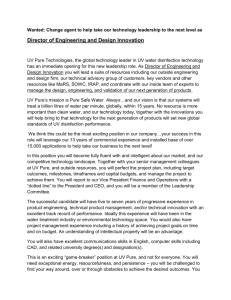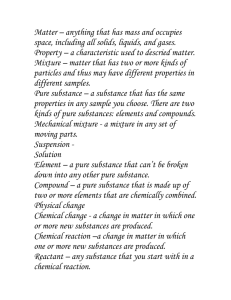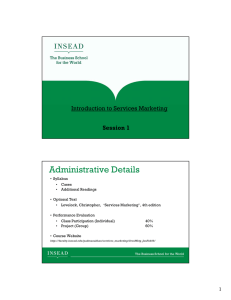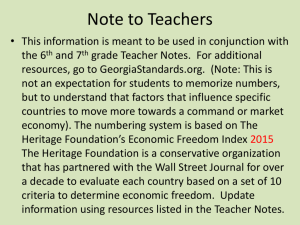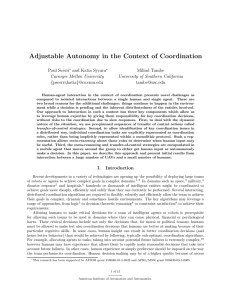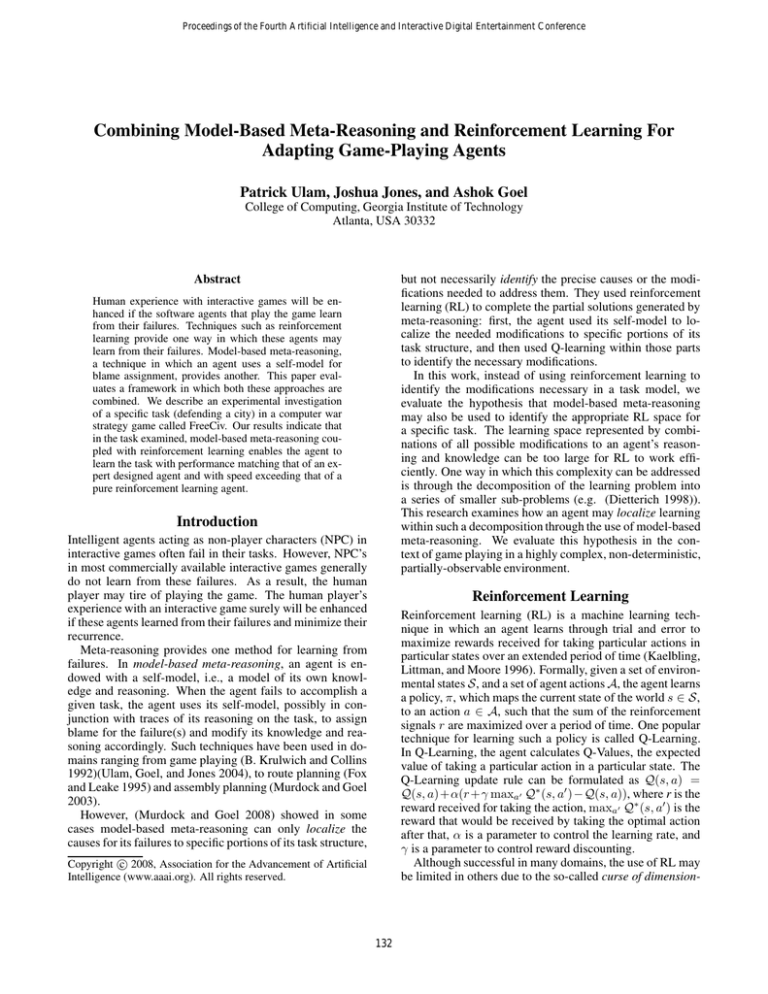
Proceedings of the Fourth Artificial Intelligence and Interactive Digital Entertainment Conference
Combining Model-Based Meta-Reasoning and Reinforcement Learning For
Adapting Game-Playing Agents
Patrick Ulam, Joshua Jones, and Ashok Goel
College of Computing, Georgia Institute of Technology
Atlanta, USA 30332
but not necessarily identify the precise causes or the modifications needed to address them. They used reinforcement
learning (RL) to complete the partial solutions generated by
meta-reasoning: first, the agent used its self-model to localize the needed modifications to specific portions of its
task structure, and then used Q-learning within those parts
to identify the necessary modifications.
In this work, instead of using reinforcement learning to
identify the modifications necessary in a task model, we
evaluate the hypothesis that model-based meta-reasoning
may also be used to identify the appropriate RL space for
a specific task. The learning space represented by combinations of all possible modifications to an agent’s reasoning and knowledge can be too large for RL to work efficiently. One way in which this complexity can be addressed
is through the decomposition of the learning problem into
a series of smaller sub-problems (e.g. (Dietterich 1998)).
This research examines how an agent may localize learning
within such a decomposition through the use of model-based
meta-reasoning. We evaluate this hypothesis in the context of game playing in a highly complex, non-deterministic,
partially-observable environment.
Abstract
Human experience with interactive games will be enhanced if the software agents that play the game learn
from their failures. Techniques such as reinforcement
learning provide one way in which these agents may
learn from their failures. Model-based meta-reasoning,
a technique in which an agent uses a self-model for
blame assignment, provides another. This paper evaluates a framework in which both these approaches are
combined. We describe an experimental investigation
of a specific task (defending a city) in a computer war
strategy game called FreeCiv. Our results indicate that
in the task examined, model-based meta-reasoning coupled with reinforcement learning enables the agent to
learn the task with performance matching that of an expert designed agent and with speed exceeding that of a
pure reinforcement learning agent.
Introduction
Intelligent agents acting as non-player characters (NPC) in
interactive games often fail in their tasks. However, NPC’s
in most commercially available interactive games generally
do not learn from these failures. As a result, the human
player may tire of playing the game. The human player’s
experience with an interactive game surely will be enhanced
if these agents learned from their failures and minimize their
recurrence.
Meta-reasoning provides one method for learning from
failures. In model-based meta-reasoning, an agent is endowed with a self-model, i.e., a model of its own knowledge and reasoning. When the agent fails to accomplish a
given task, the agent uses its self-model, possibly in conjunction with traces of its reasoning on the task, to assign
blame for the failure(s) and modify its knowledge and reasoning accordingly. Such techniques have been used in domains ranging from game playing (B. Krulwich and Collins
1992)(Ulam, Goel, and Jones 2004), to route planning (Fox
and Leake 1995) and assembly planning (Murdock and Goel
2003).
However, (Murdock and Goel 2008) showed in some
cases model-based meta-reasoning can only localize the
causes for its failures to specific portions of its task structure,
Reinforcement Learning
Reinforcement learning (RL) is a machine learning technique in which an agent learns through trial and error to
maximize rewards received for taking particular actions in
particular states over an extended period of time (Kaelbling,
Littman, and Moore 1996). Formally, given a set of environmental states S, and a set of agent actions A, the agent learns
a policy, π, which maps the current state of the world s ∈ S,
to an action a ∈ A, such that the sum of the reinforcement
signals r are maximized over a period of time. One popular
technique for learning such a policy is called Q-Learning.
In Q-Learning, the agent calculates Q-Values, the expected
value of taking a particular action in a particular state. The
Q-Learning update rule can be formulated as Q(s, a) =
Q(s, a)+α(r +γ maxa Q∗ (s, a )−Q(s, a)), where r is the
reward received for taking the action, maxa Q∗ (s, a ) is the
reward that would be received by taking the optimal action
after that, α is a parameter to control the learning rate, and
γ is a parameter to control reward discounting.
Although successful in many domains, the use of RL may
be limited in others due to the so-called curse of dimension-
c 2008, Association for the Advancement of Artificial
Copyright Intelligence (www.aaai.org). All rights reserved.
132
Defend-City. This task pertains to the defense of one of the
agent’s cities from enemy civilizations.
ality: the exponential growth of the state space required to
represent additional state variables. In these domains, the
curse of dimensionality prevents the use of RL without significant abstraction of the state space. To overcome this limitation, many have investigated the incorporation of background knowledge into the RL problem (e.g. in the form of a
hierarchical task decomposition). In this context, a task can
be defined as a goal that the agent must achieve (e.g. buying an apple at the store) A task decomposition, therefore,
can be viewed as the set of sub-goals necessary to achieve
the overall goal. By decomposing the task to be learned into
several smaller tasks, the state space used by the reinforcement learner can be reduced to a more manageable level.
A number of variants of hierarchical RL exist many of
which are rooted in the theory of Semi-Markov decision
processes (Barto and Mahadevan 2003). Hierarchical RL
techniques such as MAXQ value decomposition (Dietterich
1998) rely on domain knowledge in order to determine the
hierarchy of tasks that must be accomplished by the agent,
as does our approach. However, in our approach, the agent
uses model-based meta-reasoning to determine the portion
of the task structure over which the reward should be applied during task execution. Furthermore, many hierarchical
methods focus on abstractions of temporally extended actions for the hierarchy (Sutton, Precup, and Singh 1999);
our approach uses the hierarchy to delimit natural partitions
in non-temporally extended tasks.
Anderson, et. al. (Anderson et al. 2006) have applied
meta-reasoning in the context of RL. In their ”metacognitive loop” (MCL) architecture, a metareasoning component
monitors the performance of an RL-based agent. In MCL,
meta-reasoning plays the role of monitoring for and correcting problems in RL. This is in contrast to the work described
here where meta-reasoning is used to focus RL during normal operation. The two approaches are likely to be complementary, however.
Agent Model
We built a simple agent (that we describe below) for the
Defend-City task. The agent was then modeled based on
a variant of a knowledge-based shell called REM (Murdock
and Goel 2008) using a version of a knowledge representation called Task-Method-Knowledge Language (TMKL).
REM agents written in TMKL are divided into tasks, methods, and knowledge. A task is a unit of computation; a task
specifies what is done by some computation. A method is
another unit of computation; a method specifies how some
computation is done. The knowledge portion of the model
describes the different concepts and relations that tasks and
methods in the model can use and affect as well as logical
axioms and other knowledge necessary for inference over
those concepts and relations.
Table 1 describes the functional model of the Defend-City
task as used by model-based meta-reasoning. The overall
Defend-City task is decomposed into two sub-tasks by the
Evaluate-then-Build method. These subtasks are the evaluation of the defense needs for a city and the building of
a particular structure or unit at that city. One of the subtasks, Evaluate-Defense-Needs, can be further decomposed
through the Evaluate-Defense-Needs method into two additional subtasks: a task to check internal factors in the city
for defensive requirements and a task to check for factors
external to the immediate vicinity of the city for defensive
requirements. These subtasks are then implemented at the
procedural level for execution as described below.
The Defend-City task is executed each turn that the agent
is not building a defensive unit in a particular city in order
to determine if production should be switched to a defensive
unit. It is also executed each turn that a defensive unit has
finished production in a particular city. The internal evaluation task utilizes knowledge concerning the current number
of troops that are positioned in and around a particular city
to determine if the city has an adequate number of defenders based on available information. This is implemented as
a relation in the form of the evaluation of the linear expression: allies(r) + d ≥ t where allies(r) is the number of
allies within radius r, d is the number of defenders in the
city and t is a threshold value. The external evaluation of a
city’s defenses examines the area within a specified radius
around a city for nearby enemy combat units. It uses the
knowledge of the number of units, their distance from the
city, and the number of units currently allocated to defend
the city in order to provide an evaluation of the need for
additional defense. This is also implemented as a relation
in the form of the linear expression enemies(r) + et ≤ d
where enemies(r) is the number of enemies in radius r of
the city, et is a threshold value, and d is the number of defenders in the city. These tasks produce knowledge states
in the form of defense recommendations that are then used
by the task that builds the appropriate item at the city. The
Build-Defense task uses the knowledge states generated by
the evaluation subtasks, knowledge concerning the current
The FreeCiv Game
The domain for our experimental investigation is a popular
computer war strategy game called FreeCiv. FreeCiv is a
multi-player game in which a player competes either against
several software agents that come with the game or against
other human players. Each player controls a civilization that
becomes increasingly modern as the game progresses. As
the game progresses, each player explores the world, learns
more about it, and encounters other players. Each player can
make alliances with other players, attack the other players,
and defend their own assets from them. FreeCiv provides a
highly complex domain in which the agent must operate. In
the course of a game (that can take many hours to play) each
player makes a large number of decisions for his civilization
ranging from when and where to build cities on the playing
field, to what sort of infrastructure to build within the cities
and between the civilizations’ cities, to how to defend the
civilization.
Due the highly complex nature of the FreeCiv game, our
work so far has addressed only subtasks within the game,
and not the game as a whole. Due to limitations of space, in
this paper we describe only one task in detail, which we call
133
glect of infrastructure in a particular city that can be partially
alleviated by focusing the city on wealth/luxury production.
Table 1: TMKL Model of Defend-City Task
TMKL Model of the Defend-City Task
Task
Defend-City
by Evaluate-Then-Build
makes City-Defended
Method
Evaluate-Then-Build
transitions:
state: s1 Evaluate-Defense-Needs
success s2
state: s2 Build-Defense
success success
additional-result City-Defended, Unit-Built
Wealth-Built
Task
Evaluate-Defense-Needs
input External/Internal-Defense-Advice
output Build-Order
by UseDefenseAdviceProcedure
makes DefenseCalculated
Method
Evaluate-Defense-Needs
transitions:
state: s1 Evaluate-Internal
success s2
state: s2 Evaluate-External
success success
additional-result Citizens-Happy, Enemies-Accounted
Allies-Accounted
Task
Evaluate-Internal
input Defense-State-Info
output Internal-Defense-Advice
by InternalEvalProcedure
makes Allies-Accounted, Citizens-Happy
Task
Evaluate-External
input Defense-State-Info
output External-Defense-Advice
by ExternalEvalProcedure
makes Enemies-Accounted
Task
Build-Defense
input BuildOrder
by BuildUnitWealthProcedure
makes Unit-Built, Wealth-Built
Experimental Setup
We compared four variations of the Defend-City agent to
determine the effectiveness of model-based meta-reasoning
in guiding RL. These were a control agent, a pure metareasoning agent, a pure RL agent, and a meta-reasoningguided RL agent. The agents are described in detail below.
Each experiment was composed of 100 trials and each
trial was set to run for one hundred turns at the hardest difficulty level in FreeCiv against eight opponents on the smallest game map available. These opponents were controlled
by the standard AI that comes built into the FreeCiv engine.
The same map was used for each trial across all agents. Tax
rates in each scenario were set to 40% research, 30% income, and 30% luxury. Within this work, the city to be
defended was built at the starting location. Any additional
units available at the outset of the game (typically one or
two) randomly explored in the vicinity of this city. If an opponent was discovered, these units did not actively engage
in offensive behavior. The Defend-City task is considered
successful if the city neither revolted nor was defeated. If
the task was successful no adaptation of the agent occurred.
If the agent’s city is conquered or the city’s citizens revolt,
the Defend-City task is considered failed. Execution of the
task is halted and adaptation appropriate to the type of agent
is initiated. The metrics measured in these trials include the
number of successful trials in which the city was neither defeated nor did the city revolt. In addition, the number of attacks successfully defended per game was measured under
the assumption that the more successful the agent in defending the city, the more attacks it will be able to successfully
defend against. The final metric measured was the number
of trials run between failures of the task. This was included
as a means of determining how quickly the agent was able
to learn the task and is included under the assumption that
an agent with longer periods between task failures indicate
that the task has been learned more effectively.
Control Agent
The control agent was set to follow the initial model of the
Defend-City task and was not provided with any means of
adaptation. The initial Defend-City model used in all agents
executes the Evaluate-External task only looking for enemy units one tile away from the city. The initial EvaluateInternal task only looks for defending troops in the immediate vicinity of the city and if there are none, will build a
single defensive unit. The control agent will not change this
behavior over the lifetime of the agent.
status of the build queue, and the technology currently available to the agent to determine what should be built for a
given iteration of the task. The Build Defense task will then
proceed to build a defensive unit, either a warrior or a phalanx based on the technology level achieved by the agent at
that particular point in the game, or wealth to indirectly keep
the citizens of the city happy. The goal of the Defend-City
task is to provide for the defense of a city for a certain number of years. The task is considered successful if the city
has not been conquered by opponents by the end of this time
span. If the enemy takes control of the city the task is considered a failure. In addition, if the city enters civil unrest,
a state in which the city revolts because of unhappiness, the
task is considered failed. Civil unrest is usually due the ne-
Pure Model-Based Meta-Reasoning Agent
The second agent was provided capabilities of adaption
based purely on model-based meta-reasoning. Upon failure
of the Defend-City task, the agent used an execution trace
of the last twenty executions of the task, and in conjunction
with the current model, it performed failure-driven modelbased adaptation. The first step is the localization of the
134
Table 2: State variables for RL Based Agents
Pure RL State Variables Additional State Variables Associated Sub-Task
≤ 1 Allies in City
Evaluate-Internal
≤ 3 Allies in City
Evaluate-Internal
≤ 6 Allies in City
Evaluate-Internal
≤ 1 Allies Nearby
Evaluate-Internal
≤ 2 Allies Nearby
Evaluate-Internal
≤ 4 Allies Nearby
Evaluate-Internal
≤ 1 Enemies Nearby
Evaluate-External
≤ 3 Enemies Nearby
Evaluate-External
≤ 6 Enemies Nearby
Evaluate-External
Internal Recommend
Evaluate-Defense
External Recommend
Evaluate-Defense
tion Citizens-Happy and the failure can be localized to that
particular task. An extensive discussion on failure localization in meta-reasoning can be found in (Murdock and Goel
2008). Given the location in the model from which the failure is suspected to arise, the agent then analyzes the execution traces available to it to determine to the best of its
ability what the type of error occurred in the task execution
through the use of domain knowledge. For this agent, error
localization occurs through the use of a failure library containing common failure conditions found within the DefendCity task. An example of a failure library used in this task is
shown in Table 3. This failure library is typically the product
of the existing task model in that the elements in the library
map directly to the assertions that should result from executing a task within the model. For example, the task model
indicates that the Evaluate-Internal sub-task should result in
the assertion Citizens-Happy. One of the failures within the
library would therefore be the case in which the citizens are
not made happy.
If a failure has been determined to have occurred, it is
then used to index into a library of adaptation strategies that
will modify the task in the manner indicated by the library.
These adaptations consist of small modifications to the subtasks in the defend city tasks, such as changing the EvaluateExternal subtask to look for enemies slightly further away.
These adaptations can be seen as a variation on fixed value
production repair as described by (Murdock and Goel 2008).
If multiple errors are found with this procedure, a single error is chosen stochastically so as to minimize the chance of
over-adaptation of the agent.
Table 3: Failure types used in the Defend-City task
Model Location (task) Types of Failures
Defend-City
Unit-Build-Error,
Wealth-Build-Error,
Citizen-Unrest-Miseval,
Defense-Present-Miseval,
Proximity-Miseval,
Threat-Level-Miseval,
None
Build-Defense
Unit-Build-Error,
Wealth-Build-Error,
None
Evaluate-Internal
Citizen-Unrest-Miseval,
Defense-Present-Miseval,
None
Evaluate-External
Proximity-Miseval,
Threat-Level-Miseval,
None
error through the use of feedback in the form of the type of
failure, and the model of the failed task. Using the feedback, the model is analyzed to determine in which task the
failure has occurred. For example, if the Defend-City task
fails due to citizen revolt the algorithm would take as input: the Defend-City model, the traces of the last twenty
executions of the task, and feedback indicating that the failure was a result of a citizen revolt in the city. The failure
localization algorithm would take the model as well as the
feedback as input. As a city revolt is caused by unhappy
citizens, this information can be utilized to help localize
where in the model the failure may have occurred. This algorithm will go through the model, looking for methods or
tasks that result in knowledge states concerning the citizens’
happiness. It will first locate the method Evaluate-DefenseNeed and find that this method should result in the assertion
Citizens-Happy. It will continue searching the sub-tasks of
this method in order to find if any sub-task makes the assertion Citizens-Happy. If not, then the error can be localized
to the Evaluate-Defense-Need task and all sub-tasks below
it. In this case, the Evaluate-Internal task makes the asser-
Pure Reinforcement Learning Agent
The third agent used a pure RL strategy for adaptation implemented via Q-Learning (described in detail in section 2).
The state space encoding used by this agent is a set of nine
binary variables as seen in Table 2. This allows a state space
of 512 distinct states. It should be noted, however, that not
all states are reachable in practice. The set of actions available to the agent were: Build Wealth, Build Military Unit.
The agent received a reward of -1 when the Defend-City
task failed and a reward of 0 otherwise. In all trials alpha
was kept constant at 0.8 and gamma was set to 0.9.
135
Failures
Number of Failures
Proportion of Attacks Defended
100
1
80
0.8
60
0.6
40
0.4
20
0.2
0
Control
ModelBased
Pure RL
Model+RL
0
Control
Type of Adaptation
Model Based
Pure RL
Model+RL
Figure 2: Proportion of Attacks Defended
Figure 1: Number of Failures
Trials Between Failures
Average Trials beween Failures
Meta-Reasoning-Guided RL Agent
The final agent utilized model-based meta-reasoning in conjunction with RL. The Defend-City task model was augmented with RL by partitioning the state space utilized by
the pure RL agent into three distinct state spaces that are then
associated with the appropriate sub-tasks of the Defend-City
task. This essentially makes several smaller RL problems.
Table 2 shows the states that are associated with each subtask. The Evaluate-External task is associated with three
binary state variables. Its resulting actions consist of either a recommendation that defensive units be built or a recommendation that defensive units should not be built. In
a similar manner, Evaluate-Internal is associated with six
binary state variables as shown Table 2. The actions are
also a binary value representing the relation used in the pure
meta-reasoning agent. There are two additional state variables in this agent that are associated with the EvaluateDefenses sub-task. The state space for this particular portion
of the model are the outputs of the Evaluate-External and
Evaluate-Internal tasks and is hence two binary variables.
The actions for this RL task is also a binary value indicating a yes or no decision on whether defensive units should
be built. It should be noted that while the actions of the individual sub-tasks are different from the pure RL agent, the
overall execution of the Defend-City task results in two possible actions for all agents, namely an order to build wealth
or to build a defensive unit. Upon a failure in the task execution, the agent initiates meta-reasoning in a manner identical
to the pure meta-reasoning agent. Utilizing a trace of the last
twenty executions of the Defend-City task as well as its internal model of the Defend-City task, the agent localizes the
failure to a particular portion of the model as described in
section 5.2. If an error in the task execution is detected, instead of utilizing adaptation libraries to modify the model of
the task as in the pure meta-reasoning agent, the agent applies a reward of -1 to the sub-task’s reinforcement learner as
indicated via meta-reasoning. The reward is used to update
the Q-values of the sub-task via Q-Learning at which point
the adaptation for that trial is over. If no error is found, then a
reward of 0 is given to the appropriate reinforcement learner.
In all trials alpha was kept constant at 0.8 and gamma was
set to 0.9.
5
4
Control
3
RL
2
Model
1
Model+RL
0
1 3 5 7 9 11 13 15 17 19 21
Failures
Figure 3: Average Number of Trials Between Failures
Results and Discussion
Figure 1 depicts the number of trials in which a failure occurred out of the one hundred trials run for each agent. The
more successful adaptation methods should have a lower
failure rate. As can be seen from the results, the metareasoning-guided RL agent proved most effective at learning
the Defend-City task, with a failure rate of around half that
of the control agent. The pure meta-reasoning agent with
the hand designed adaptation library proved to be successful also with a failure rate slightly higher then that of the
meta-reasoning-guided RL agent. The pure RL agent’s performance did not match either of the other two agents in this
metric. The pure RL agent’s failure rate did improve over
that of the control, however, indicating that some learning
did take place, but not at the rate of either the pure metareasoning agent or the meta-reasoning-guided RL agent.
The second metric measured was the proportion of attacks
successfully defended by the agent in its city. This serves
as another means of determining how effectively the agent
has been able to perform the Defend-City task. The more
attacks that the agent was able to defend, the more successfully the agent had learned to perform the task. The results
from this metric can be seen in Figure 2. As the default
parametrization of all agents results in one defensive unit being built, this metric will not be below 50% for any agent (a
city with one denfensive unit will always be able to defend
against at least one attack). Both the pure meta-reasoning
and meta-reasoning-guided RL agent were able to defend
against around an equal number of attacks per trial (approx.
6 defenses per trial) indicating that both methods learned
the task to an approximately equal degree of effectiveness.
The pure RL based agent exceeded the performance of the
136
equaled that of either the pure meta-reasoning agent or the
meta-reasoning-guided RL agent within the allotted number of trials. Secondly, the meta-reasoning-guided RL agent
shows benefits over the pure meta-reasoning agent, matching the performance of that agent in the metrics measured in
addition to learning the task in fewer trials. In addition, the
augmented agent eliminates the need for an explicit adaptation library such as is used in the pure-model based agent
and thus results in a significant reduction in the knowledge
engineering required by the designer. This work has only
looked at an agent that can play a small subset of FreeCiv.
Future work will focus largely on scaling up this method to
include other aspects of the game and hence larger models
and larger state spaces.
control (approx. 2.5 vs. 1.5 defenses per trial) but was significantly less effective then the meta-reasoning methods,
once again lending support to the conclusion that the pure
RL based agent is hampered by its slow convergence times.
This result, coupled with the number of failures, provide significant evidence that the meta-reasoning methods learned to
perform the task with a significant degree of precision. They
not only reduced the number of failures when compared to
the control and pure RL based agent, but were also able to
defend the city from more than twice as many attacks per
trial.
Figure 3 depicts the average number of trials between
failures for the first twenty-five failures of each agent averaged over a five trial window for smoothing purposes. This
metric provides a means of measuring the speed of convergence of each of the adaptation methods. It is assumed that
as the agent learns the Defend-City task within the the experiment, the frequency of failures will decrease. As such,
the rate in which the failures decrease can be used measure
how quickly the agent learns the task. As can be seen, the
meta-reasoning-guided RL agent shows the fastest convergence speed followed by the non-augmented meta-reasoning
agent. The pure RL agent did not appear to improve until around the twelfth failure. After this point the control
and the pure RL agent inter-trial failure rate begin to deviate
slowly. Though not depicted in the figure, the performance
of the pure RL based agent never exceeded a inter-trial failure rate of three even after all trials were run. This lends
evidence to the hypothesis that pure RL cannot learn an appropriate solution to this problem in the allotted number of
trials though the performance of this agent did outperform
the control. The meta-reasoning-guided RL agent outperformed the pure meta-reasoning agent in this metric. Finally, the difference in all performance metrics for the pure
RL agent and the meta-reasoning guided RL agent serve to
illustrate the importance of the problem decomposition and
localization in the agent’s ability to learn the task.
Beyond the experiments described in this paper, we have
also applied meta-reasoning-guided RL to another problem
in FreeCiv. While the results for this new domain are still
preliminary, this work bears mention as it helps establish
the generality of the approach. In this alternative setting, an
agent learns to make decisions about when to use it units
to actively attack enemy units within FreeCiv. These preliminary results found that the agent, when equipped with a
model of its reasoning and a decomposed RL state space appropriate for this domain, was able to significantly improve
its performance (measured as the percentage of engaged enemies defeated) against the control, an agent which engages
enemy units stochastically.
Acknowledgments
This work was supported in part by an NSF (SoD) grant
(#0613744) on Teleological Reasoning in Adaptive Software Design.
References
Anderson, M. L.; Oates, T.; Chong, W.; and Perlis, D.
2006. The metacognitive loop I: Enhancing reinforcement
learning with metacognitive monitoring and control for improved perturbation tolerance. J. Exp. Theor. Artif. Intell.
18(3):387–411.
B. Krulwich, L. B., and Collins, G. 1992. Learning several
lessons from one experience. In Proceedings of the 14th
Annual Conference of the Cognitive Science Society, 242–
247.
Barto, A. G., and Mahadevan, S. 2003. Recent advances
in hierarchical reinforcement learning. Discrete Event Dynamic Systems 13(4):341–379.
Dietterich, T. G. 1998. The MAXQ method for hierarchical reinforcement learning. In Proceedings of the Fifteenth
International Conference on Machine Learning, 118–126.
Fox, S., and Leake, D. B. 1995. Using introspective reasoning to refine indexing. In Proceedings of the Thirteenth
International Joint Conference on Artificial Intelligence.
Kaelbling, L. P.; Littman, M. L.; and Moore, A. P. 1996.
Reinforcement learning: A survey. Journal of Artificial
Intelligence Research 4:237–285.
Murdock, W., and Goel, A. K. 2003. Localizing planning with functional process models. In Proceedings of the
Thirteenth International Conference on Automated Planning and Scheduling.
Murdock, J. W., and Goel, A. K. 2008. Meta-case-based
reasoning: self-improvement through self-understanding.
J. Exp. Theor. Artif. Intell. 20(1):1–36.
Sutton, R. S.; Precup, D.; and Singh, S. P. 1999. Between MDPs and semi-MDPs: A framework for temporal abstraction in reinforcement learning. Artificial Intelligence 112:181–211.
Ulam, P.; Goel, A.; and Jones, J. 2004. Reflection in action:
Model-based self-adaptation in game playing agents. In
AAAI Challanges in Game AI Workshop.
Conclusions
This work describes how model-based meta-reasoning may
guide RL. In the experiments described, this has been shown
to have two benefits. The first is a reduction in learning
time as compared to an agent that learns the task via pure
RL. The model-guided RL agent learned the task described,
and did so faster then the pure RL based agent. In fact,
the pure RL based agent did not converge to a solution that
137


